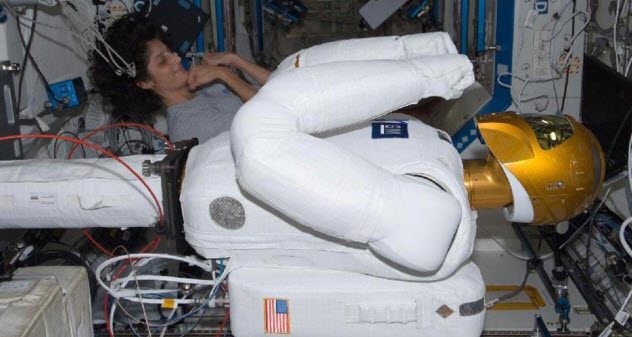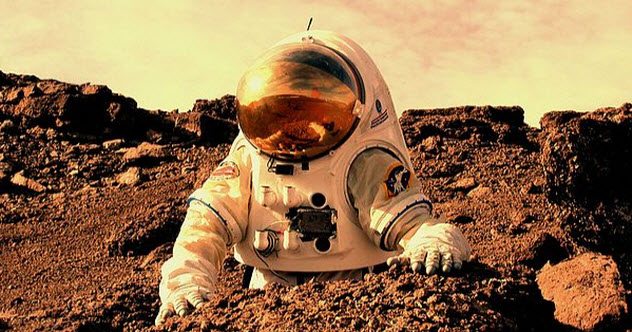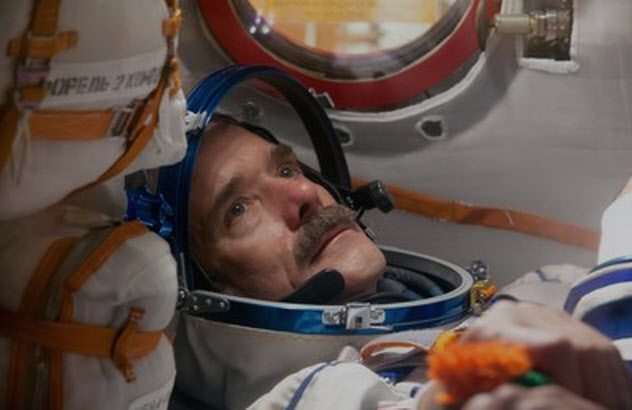 Technology
Technology  Technology
Technology  Mysteries
Mysteries 10 Mysteries of the Human Genome
 Weird Stuff
Weird Stuff 10 Things So Rare They’ve Only Been Found Once
 History
History 10 Legends Whose Last Moments Undid Their Glory
 Health
Health 10 Futuristic Ideas to Treat Common Medical Problems
 Weird Stuff
Weird Stuff Ten Surreal Attempts to Reverse Baldness
 Facts
Facts 10 U.S. Government Contingency Plans for the Unthinkable
 History
History 10 Weird Distractions from the Great Depression
 Movies and TV
Movies and TV 10 Fictional Kings Who Go from Good to Bad
 Food
Food The Fantastic Chemistry Behind Why 10 Popular Foods Taste So Good
 Technology
Technology 10 Modern Technologies That Accidentally Imitate Ancient Magic
 Mysteries
Mysteries 10 Mysteries of the Human Genome
 Weird Stuff
Weird Stuff 10 Things So Rare They’ve Only Been Found Once
Who's Behind Listverse?

Jamie Frater
Head Editor
Jamie founded Listverse due to an insatiable desire to share fascinating, obscure, and bizarre facts. He has been a guest speaker on numerous national radio and television stations and is a five time published author.
More About Us History
History 10 Legends Whose Last Moments Undid Their Glory
 Health
Health 10 Futuristic Ideas to Treat Common Medical Problems
 Weird Stuff
Weird Stuff Ten Surreal Attempts to Reverse Baldness
 Facts
Facts 10 U.S. Government Contingency Plans for the Unthinkable
 History
History 10 Weird Distractions from the Great Depression
 Movies and TV
Movies and TV 10 Fictional Kings Who Go from Good to Bad
 Food
Food The Fantastic Chemistry Behind Why 10 Popular Foods Taste So Good
10 Ways Your Mars Trip Will Be More Uncomfortable Than You Think
Rapid advances in space exploration combined with doom and gloom happening in the news are causing more people than ever to turn a romantic eye to the stars. The idea of exploring and inhabiting Mars has gone from a futuristic dream to a tangible, even imminent goal. There are many organizations currently performing experiments and making plans to extend human spaceflight to the Red Planet.
Currently, NASA is planning its Orion mission, which will send between two and six people to explore Mars. In addition, the European Space Agency, many private ventures, Russia, India, China, and Japan are also in the planning stages to send humans all the way to the fourth planet from the Sun.
Many organizations and scientists warn that we are using Earth’s resources far too rapidly to sustain life here. Unfortunately, some people have taken these studies to mean that we should abandon Earth and focus on migrating to other planets as soon as possible.
Scientists warn that we should not look to Mars as a “Next Earth” that can meet all the needs of humanity if we destroy this planet. Neil DeGrasse Tyson has said that the technology is feasible to terraform, rebuild, and alter Mars into an Earthlike habitat. But he also explained, “If we have the power to turn another planet into Earth, then we can turn Earth back into Earth!”
With all the uncertainty surrounding the future, we should really focus on doing both. Still, if your curiosity outweighs your fears, you should read on to learn just what you will be getting yourself into! And if you decide to travel to Mars, we can’t wait to see the pictures you send home.
10 Loneliness

Far from a slight inconvenience, severe loneliness can actually cause serious health problems. Even if Mars becomes fairly well-populated with travelers eventually, there is little chance that it will replicate the closely linked communities and societies that have been built for centuries on Earth.
To combat the darker effects of having fewer humans with whom to interact, travelers to Mars might do things like have conversations with robots and engage in complex individual activities.[1]
9 Loss Of Muscle Mass
If you have seen footage of astronauts aboard the International Space Station, you may have noticed that they spend quite a lot of time exercising on stationary bikes and other equipment. They do this because a change in gravity has a massive impact on the body’s muscular structure.
As residents of Earth, we hardly notice the work done by our “antigravity” muscles, namely the quadriceps and the muscles in the calves, neck, and back.[2] But without the daily pressure of gravity on those body parts, the loss of ability would become quickly apparent.
At the moment, countermeasures to keep people’s bodies working and healthy—especially their muscular systems—have been studied for short-term flights and stays. However, no one has ever spent decades or entire lifetimes on a distant planet. So it has been impossible to really study the long-term impact of living in those places.
The health of your muscles also directly impacts your skeletal system, reproductive health, and organs.
8 Depleted Oxygen

There are several ways to create oxygen from other materials during space travel and planet habitation. However, the levels on a planet like Mars will not be able to match the oxygen available on Earth for quite some time.
Your body needs oxygen for almost all its life functions—from breathing to digestion to cell division and growth. In the future, solid oxide electrolysis may be used to extract oxygen from the carbon dioxide that makes up 95 percent of Mars’ atmosphere.[3]
7 Extreme Temperatures

The atmosphere on Mars is so thin that it’s almost impossible for the planet to retain heat. The planet’s average temperature is -62 degrees Celsius (-81 °F).[4] In case it wasn’t already clear, that’s really, really cold.
If you thought that forgetting to pack mittens for your ski trip was unpleasant, just wait until you find yourself shivering on a stark, distant planet with no department stores from which to buy throw blankets!
6 Incredibly Long Travel Time

Talk about a never-ending road trip! While probes can get to Mars in no time, actually sending humans all the way to Mars will take much longer. Even the shorter proposals, which would take extremely high amounts of energy to achieve, could take 400 or 500 days.[5] Better pack some extra snacks!
5 Radiation

First, you will be pelted with radiation on the way to Mars. Then, for the entire time that you live there, you will have to take constant precautions to avoid increased exposure. Assuming you decide to come home again, your radiation exposure will continue all the way back.
Both galactic cosmic rays (GCR) and solar energetic particles (SEP) can cause irreversible damage to the human body. Just being on the Red Planet exposes astronauts to more than 100 times the radiation that they would be subjected to on Earth, and the rides there and back are even riskier.[6]
The high-energy and minuscule particles of radiation can tear right through the human body and other materials. The damage can cause changes to DNA and cells.
In the human brain, this can lead to deterioration and seizures. Eyes can get cataracts, lungs can develop cancer, and skin can be broken and even burned. Hearts and digestive organs are weakened, and yes, radiation can even make a person sterile.
Still, not to worry too much, the materials used to combat this exposure just keep getting stronger and more versatile!
4 Claustrophobia

Before even selecting a crew, NASA and other spaceflight organizations test people for extreme claustrophobia. According to astronaut Chris Hadfield, the tests for him were actually enjoyable, including one where you are strapped into a small black bag and not told when you will be let out.[7]
Hadfield said that “being zipped inside a small, dark place for an indeterminate amount of time was just a great opportunity and nice time to think and maybe have a little nap and relax.” For most of us, that would be a much more unpleasant experience.
Still, even the most steely and brave among selected astronauts have some end in sight as they spend their days in incredibly tight spaces. Eventually, they know they will return home to the vast, open skies and fresh air of Earth.
Imagine having to spend the rest of your life on Mars, traveling between small compartments and stations to avoid radiation and maintain proper oxygen levels. You would never be able to explore and travel outside your camp without a claustrophobia-inducing space suit and helmet.
3 Hostile Life-Forms

There is a reason that astronauts have been carrying weapons with them into space for decades “just in case.” These have included the orbital survival knives of the 1960s, machetes, and even machete guns and pistols.
While the larger claim is that astronauts could encounter survival situations on their return to Earth by landing on unsafe terrain or in hostile territory, the second cause is stated far less often. Although no solid proof of sentient life has been found yet, the existence of extraterrestrial microorganisms is all but guaranteed based on fossilized evidence. Also, the probability that other life-forms exist is so high that it’s almost undeniable.
In fact, in 2016, scientists determined that the likelihood that we are the only advanced species in any galaxy is less than 1 in 60 billion. If we look at the unique qualities of species and individuals solely on our own planet, the chances of encountering Martian life-forms that are friendly or hostile are almost equally high.[8]
Think about all the times you’ve had to live with a crummy roommate or neighbor, and then multiply that by one million to calculate the impact of sharing a planet with a life-form that doesn’t like having you around.
2 Deformed Eyes And Vision Loss

NASA began asking astronauts about their vision after space travel around 1989. Whenever an astronaut returned home, researchers would try to determine if their distance and near vision were in any way impaired. What they learned was shocking at first. Many astronauts seemed to have much more difficulty seeing than they had experienced before leaving Earth.
NASA decided that they needed to investigate much more systematically. They started performing more detailed tests, including binocular indirect opthalmoscopy (a way to view the back of the eye through the retina), cycloplegic refraction (a way to rule out different problem areas by relaxing other areas with eye drops), and dilated fundus examinations (which gives a clearer view of the eye by dilating pupils with eye drops).[9]
The poorer results after space travel sometimes lasted many years or were even permanent. It turned out that the eye itself was actually changing, along with the brain and spinal fluid. A strong possible culprit is intracranial hypertension, or high pressure placed on the brain and spine.
Currently, Valeri Polyakov holds the record for the longest consecutive time in space of 437 days. Factoring in various complications and variances in the distance, your trip to Mars could easily take several hundred days and that’s just getting there. The longer you stay in an altered state of gravity, the higher the risk of experiencing these medical issues.
1 Space Madness

Before humans took to the stars, scientists worried that travelers in space would eventually become “impulsive, suicidal, sexually aberrant thrill seekers.” They thought that being trapped in small spaces and devoid of modern comforts would make spacefarers snap. In actuality, the first professional astronauts were steely, calm, and even courageous in life-threatening situations.
Since many of the darkest fears of the day were eventually disproved, the idea of space madness became a bit of an urban legend. Still, there were occasional examples of people who could not handle the pressures of space. Some people exhibited strange behaviors after their brief travels outside the atmosphere.
Travel to Mars would take so much longer than currently clocked space travel that any symptoms witnessed so far would almost certainly be amplified on that long journey. In addition, your brain is made up of a large percentage of water. The effects from the change in gravity on the makeup of the brain have barely been studied.[10]
At the moment, NASA is studying participants aboard the International Space Station for changes in brain plasticity using various tests. Throughout their journeys, astronauts perform small tasks, from mentally rotating images to finishing a foam obstacle course. The rises and falls in their abilities are monitored over time.
Katie Allen is a writer, illustrator, and exobiology enthusiast.
Read about more issues that may hinder a human trip to Mars on 10 Issues That Are Hindering a Voyage to Mars and 10 Obscure Issues That Hinder Manned Missions To Mars.








